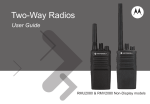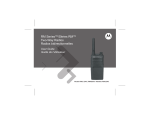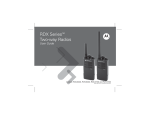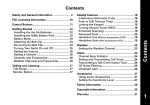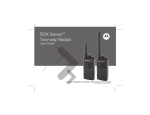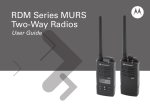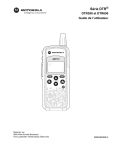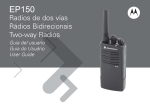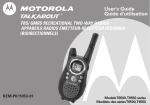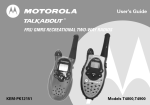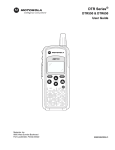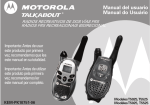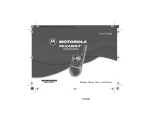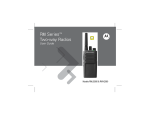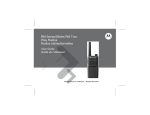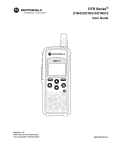Download Motorola RMU2080D Two-Way Radio User Manual
Transcript
Two-Way Radios User Guide RMU2080d Display model Open Source Software Legal Notices: This Motorola product contains Open Source Software. For information regarding licenses, acknowledgements, required copyright notices and other usage terms, refer to the documentation for this Motorola product at: http://businessonline.motorolasolutions.com Go to: Resource Center > Product Information > Manual > Accessories. CONTENTS 1 15 15 16 17 17 18 18 19 20 21 23 24 26 28 28 28 28 29 29 29 CONTENTS Contents. . . . . . . . . . . . . . . . . . . . . . . . . . . . .1 Product Safety . . . . . . . . . . . . . . . . . . . . . . . .4 Introduction . . . . . . . . . . . . . . . . . . . . . . . . . .5 Package Contents . . . . . . . . . . . . . . . . . . . . . .5 FCC Licensing Information . . . . . . . . . . . . .7 Interference Information . . . . . . . . . . . . . . . . .7 Batteries and Chargers Safety Information. . . . . . . . . . . . . . . . . . . . . . . . . . .9 Operational Safety Guidelines. . . . . . . . . . . .10 Radio Overview . . . . . . . . . . . . . . . . . . . . . .11 Parts Of The Radio . . . . . . . . . . . . . . . . . . . .11 On/Off/Volume Knob. . . . . . . . . . . . . . . .12 Channel Selector Knob . . . . . . . . . . . . . .12 Accessory Connector . . . . . . . . . . . . . . .12 Model Label . . . . . . . . . . . . . . . . . . . . . .12 Microphone . . . . . . . . . . . . . . . . . . . . . . .12 Antenna. . . . . . . . . . . . . . . . . . . . . . . . . .12 LED Indicator . . . . . . . . . . . . . . . . . . . . .12 Front Buttons . . . . . . . . . . . . . . . . . . . . .12 Side Buttons . . . . . . . . . . . . . . . . . . . . . .13 The Lithium-Ion (Li-Ion) Battery . . . . . . .13 Battery Features. . . . . . . . . . . . . . . . . . . . . . About the Li-Ion Battery . . . . . . . . . . . . . Battery Recycling and Disposal . . . . . . . Installing the Lithium-Ion (Li-Ion) Battery . . . . . . . . . . . . . . . . . . Removing the Lithium-Ion (Li-Ion) Battery . . . . . . . . . . . . . . . . . . Holster . . . . . . . . . . . . . . . . . . . . . . . . . . Power Supply, Adaptor and Drop-in Tray Charger . . . . . . . . . . . . . . . . . . . Battery Life Information . . . . . . . . . . . . . Battery Meter . . . . . . . . . . . . . . . . . . . . . Charging the Battery . . . . . . . . . . . . . . . Drop-in Tray Charger LED Indicators . . Estimated Charging Time . . . . . . . . . . . Multi-Unit Charger LED Indicators . . . . . Getting Started . . . . . . . . . . . . . . . . . . . . . . Turning radio ON/OFF . . . . . . . . . . . . . . . . . Adjusting Volume . . . . . . . . . . . . . . . . . . . . . Reading The Display . . . . . . . . . . . . . . . . . . Selecting a Channel . . . . . . . . . . . . . . . . . . . Talking and Monitoring. . . . . . . . . . . . . . . . . Receiving a Call . . . . . . . . . . . . . . . . . . . . . . English CONTENTS English Signal Strength Indicator and Channel Busy Indicators . . . . . . . . . . .30 Talk Range . . . . . . . . . . . . . . . . . . . . . . . . . .30 Radio LED Indicators . . . . . . . . . . . . . . . . . .32 Hands-Free Use/VOX . . . . . . . . . . . . . . . . . .33 With Compatible VOX Accessories. . . . .33 Hands Free without Accessories (iVOX) . . . . . . . . . . . . . . . . . . . . . . . . .34 Toggle Voice Prompt in User Mode . . . .34 Power Up - Tone Mode. . . . . . . . . . . . . .34 Reset to Factory Defaults . . . . . . . . . . . .34 Keypad Beeps. . . . . . . . . . . . . . . . . . . . .34 Keypad Lock/Unlock . . . . . . . . . . . . . . . .35 Menu Options . . . . . . . . . . . . . . . . . . . . . . . .35 Setting VOX /iVOX Sensitivity. . . . . . . . .35 Programming Features . . . . . . . . . . . . . . . .37 Advanced Configuration Mode . . . . . . . . . . .37 Entering Advanced Configuration Mode . . . . . . . . . . . . . . . . . . . . . . . . . .37 Programming Rx (Reception) Frequencies . . . . . . . . . . . . . . . . . . . . . . . .38 Programming Rx (Reception) Codes (CTCSS/DPL) . . . . . . . . . . . . . . . . . . . . . . .38 2 Programming Scramble . . . . . . . . . . . . . . . Programming Maximum Number Of Channels. . . . . . . . . . . . . . . . . . . . . . . . Programming Call Tones . . . . . . . . . . . . . . . Programming Microphone Gain Level . . . . . Programming Microphone Accessory Gain Level . . . . . . . . . . . . . . . . . . . . . . . . . Other Programming Features . . . . . . . . . . . Scan. . . . . . . . . . . . . . . . . . . . . . . . . . . . Programming Scan List . . . . . . . . . . . . . Programming Weather Channel . . . . . . Editing Channel Alias Name . . . . . . . . . Nuisance Channel Delete . . . . . . . . . . . Customer Programming Software (CPS) . . . . . . . . . . . . . . . . . . . . . . . . . . . . . Time-Out Timer . . . . . . . . . . . . . . . . . . . Power Select . . . . . . . . . . . . . . . . . . . . . Call Tones . . . . . . . . . . . . . . . . . . . . . . . Scramble . . . . . . . . . . . . . . . . . . . . . . . . Reverse Burst . . . . . . . . . . . . . . . . . . . . Weather Channel . . . . . . . . . . . . . . . . . . . . . NOAA Weather Alert . . . . . . . . . . . . . . . Cloning Radios. . . . . . . . . . . . . . . . . . . . . . . 39 40 40 41 42 43 43 44 44 45 46 46 47 47 47 47 48 48 50 51 Carry Accessories . . . . . . . . . . . . . . . . . . . . Software Applications. . . . . . . . . . . . . . . . . . RM Series™ Features Summary. . . . . . . . New Features . . . . . . . . . . . . . . . . . . . . . . . Programmable Buttons Chart . . . . . . . . . . Icons Chart . . . . . . . . . . . . . . . . . . . . . . . . . 77 77 79 88 90 91 CONTENTS Cloning with a Multi Unit Charger (MUC) . . . . . . . . . . . . . . . . . .51 CPS and Cloning Cables (Optional Accessory). . . . . . . . . . . . . .53 Cloning Radio using the Radio to Radio (R2R) Cloning Cable (Optional Accessory). . . . . . . . . . . . . .54 Cloning using the Customer Programming Software (CPS) . . . . . . . . . . . . . . . . . .56 Troubleshooting . . . . . . . . . . . . . . . . . . . . .57 Use and Care . . . . . . . . . . . . . . . . . . . . . . . .61 Frequency and Code Charts . . . . . . . . . . .62 RM UHF Frequencies Chart . . . . . . . . . . . . .62 RMU2080d – UHF Default Frequencies Chart . . . . . . . . . . . . . . . . . . . . . . . . . . . . . .65 CTCSS and PL/DPL Codes . . . . . . . . . . . . .66 Motorola Limited Warranty for the United States and Canada . . . . . . . . . . . . .72 Accessories . . . . . . . . . . . . . . . . . . . . . . . . .76 Audio Accessories. . . . . . . . . . . . . . . . . . . . .76 Battery . . . . . . . . . . . . . . . . . . . . . . . . . . . . . .76 Cables . . . . . . . . . . . . . . . . . . . . . . . . . . . . . .76 Chargers . . . . . . . . . . . . . . . . . . . . . . . . . . . .76 3 English PRODUCT SAFETY PRODUCT SAFETY PRODUCT SAFETY AND RF EXPOSURE COMPLIANCE ! Caution Before using this product, read the operating instructions and RF energy awareness information contained in the Product Safety and RF Exposure booklet enclosed with your radio. ATTENTION! This radio is restricted to occupational use only to satisfy FCC RF energy exposure requirements. English 4 For a list of Motorola-approved antennas, batteries and other accessories, visit the following website which lists approved accessories: www.motorolasolutions.com/RMseries INTRODUCTION Business Radios, Mailstop 1C15, Motorola Thank you for purchasing the Motorola® RM Series™ Radio. This radio is a product of Motorola's 80 plus years of experience as a world leader in the designing and manufacturing of communications equipment. The RM Series™ radios provide cost-effective communications for businesses such as retail stores, restaurants, schools, construction sites, manufacturing, property and hotel management and more. Motorola professional two-way radios are the perfect communications solution for all of today's fast-paced industries. 8000 West Sunrise Boulevard Note: INTRODUCTION Read this user guide carefully to ensure you know how to properly operate the radio before use Plantation, Florida 33322 PACKAGE CONTENTS • Radio • Holster • Lithium-Ion Battery • Power Supply • Quick Reference Guide • Warranty Card • Drop-in Tray Charger • Product Safety & RF Exposure Booklet 5 English INTRODUCTION For a copy of a large-print version of this user guide or for product-related questions, contact English 1-800-448-6686 in the USA 1-800-461-4575 in Canada 1-888-390-6456 on TTY (Text Telephone) For product related information, visit us at: www.motorolasolutions.com/RMseries 6 To transmit on these frequencies, you are FCC LICENSING INFORMATION required to have a license issued by the FCC. Application is made available on FCC Form This device complies with Part 15 of the FCC 601 and Schedules D, H, and Remittance Form 159. Rules. Operation is subject to the condition that To obtain these FCC forms, request document this device does not cause harmful 000601 which includes all forms and interference. instructions. If you wish to have the document RM Series™ Business two-way radios operate on radio frequencies that are regulated by the faxed, mailed or have questions, use the FCC LICENSING INFORMATION INTERFERENCE INFORMATION following contact information. Federal Communications Commission (FCC). Faxed contact the Fax-On- Demand system at: 1-202-418-0177 Mailed call the FCC forms hotline at: 1-800-418-FORM 1-800-418-3676 Questions regarding FCC license contact the FCC at: 1-888-CALL-FCC 1-888-225-5322 Or: http://www.fcc.gov 7 English FCC LICENSING INFORMATION Before filling out your application, you must Replacement of any transmitter component decide which frequency(ies) you can operate (crystal, semiconductor, etc.) not authorized by on. See “Frequencies and Code Charts”. For the FCC equipment authorization for this radio questions on determining the radio frequency, could violate FCC rules. call Motorola Product Services at: was intended to be distributed is subject to Changes or modifications not expressly government regulations and may be prohibited approved by Motorola may void the user’s authority granted by the FCC to operate this radio and should not be made. To comply with FCC requirements, transmitter adjustments should be made only by or under the supervision of a person certified as technically qualified to perform transmitter maintenance and repairs in the private land mobile and fixed services as certified by an organization representative of the user of those services. English Use of this radio outside the country where it 1-800-448-6686 8 3. and cord, pull by the plug rather than the cord when disconnecting the charger. 4. extension cord could result in risk of fire and electric shock. If an extension cord must be used, make sure that the cord size is 18AWG Before using the battery charger, read all the instructions and cautionary markings on the charger, • the battery, and • the radio using the battery 1. To reduce risk of injury, charge only the for lengths up to 100 feet (30.48 m), and 16AWG for lengths up to 150 feet (45.72 m). 5. To reduce risk of fire, electric shock, or injury, do not operate the charger if it has been broken or damaged in any way. Take it to a qualified Motorola service representative. 6. Do not disassemble the charger; it is not rechargeable Motorola-authorized batteries. repairable and replacement parts are not Other batteries may explode, causing personal available. Disassembly of the charger may injury and damage. 2. An extension cord should not be used unless absolutely necessary. Use of an improper This document contains important safety and operating instructions. Read these instructions carefully and save them for future reference. • To reduce risk of damage to the electric plug Use of accessories not recommended by BATTERIES AND CHARGERS SAFETY INFORMATION BATTERIES AND CHARGERS SAFETY INFORMATION result in risk of electrical shock or fire. 7. To reduce risk of electric shock, unplug the Motorola may result in risk of fire, electric charger from the AC outlet before attempting shock, or injury. any maintenance or cleaning 9 English BATTERIES AND CHARGERS SAFETY INFORMATION OPERATIONAL SAFETY GUIDELINES • Turn the radio OFF when charging battery. • The charger is not suitable for outdoor use. Use only in dry locations/conditions. • Connect charger only to an appropriately fused and wired supply of the correct voltage (as specified on the product). • Disconnect charger from line voltage by removing main plug. • The outlet to which this equipment is connected • In equipment using fuses, replacements must should be nearby and easily accessible. comply with the type and rating specified in the equipment instructions. • Maximum ambient temperature around the power supply equipment must not exceed 40°C (104°F). • Power output from the power supply unit must not exceed the ratings stated on the product label English 10 located at the bottom of the charger. • Make sure that the cord is located where it will not be stepped on, tripped over, or subjected to water, damage, or stress. RADIO OVERVIEW PARTS OF THE RADIO Antenna Audio Accessory 2 Pin Connector PTT (Push-ToTalk) Button Battery Model Label RMU2080d On/Off/Volume Knob Microphone LED Indicator SB1 - Monitor Button SB2 - Scan/ Nuisance Channel Delete Left Navigation Arrow/Programmable Button A RADIO OVERVIEW Channel Selector Knob Display Menu Right Navigation Arrow/Programmable Button B 11 English On/Off/Volume Knob Front Buttons RADIO OVERVIEW Used to turn the radio ON or OFF and to adjust the radio’s volume. Channel Selector Knob Used to switch the radio to different channels. Accessory Connector Used to connect compatible audio accessories. Model Label Indicates the model of the radio. Microphone Speak clearly into the microphone when sending a message. Antenna For model RMU2080d, the antenna is non-removable. LED Indicator Used to give battery status, power-up status, radio call information and scan status. English 12 • (Menu) Button Gives access to set up features like VOX/iVOX levels, etc. It also allows you to move through all the features while in Programming Mode. Default set to preset Channel 1. • Programmable Button Allows you to choose level or toggle options for features the Menu is on. Default set to generate current programmed call tone. Side Buttons • Programmable Button Note: A short press of either Programmable Button (A or B) tunes the radio to the preset channel and the radio will play a good chirp. You can assign different functions to these buttons via the CPS. For example: Backlight Time Out, Reverse Burst, Scan/Nuisance Channel Delete, Monitor and Call Tones. To learn more about how to program these buttons, refer to “Entering Advanced Configuration Mode” on page 37 and “Customer Programming Software (CPS)” on page 46 Push-to-Talk (PTT) Button • Press and hold down this button to talk, release it to listen. Side Button 1 (SB1) • The Side Button 1 is a general button that can be configured by the Customer Programming Software - CPS. The default setting of SB1 is ‘Monitor’. Side Button 2 (SB2) • The Side Button 2 is a general button that can be configured by the CPS. The SB2 default setting is ‘Scan/Nuisance Channel Delete’. The Lithium-Ion (Li-Ion) Battery RADIO OVERVIEW Allows you to choose level or toggle options for features the Menu is on. Default set to Backlight Mode. RM Series comes with a Standard Capacity LiIon battery. Other batteries may be available. For more information, see “Battery Features” on page 15. 13 English RADIO OVERVIEW English This User Guide covers the RMU2080d model from the RM Series radios. The radio’s model is shown on the bottom of the radio and provides the following information: Table 1: RMU2080d Radio Specifications Model Frequency Band Transmit Power (Watts) Number of Channels Antenna RMU2080d UHF 2 8 Non-removable 14 BATTERY FEATURES RM Series radios provide Lithium-Ion batteries that come in different capacities that defines the battery life. The RM Series radio comes equipped with a rechargeable Li-Ion battery. This battery should be fully charged before initial use to ensure optimum capacity and performance. Battery life is determined by several factors. Among the more critical are the regular overcharge of batteries and the average depth of discharge with each cycle. Typically, the greater the overcharge and the deeper the average discharge, the fewer cycles a battery will last. For example, a battery which is overcharged and discharged 100% several times a day, lasts fewer cycles than a battery that receives less of an overcharge and is discharged to 50% per day. Further, a battery which receives minimal overcharging and Motorola batteries are designed specifically to be used with a Motorola charger and vice versa. Charging in non-Motorola equipment may lead to battery damage and void the battery warranty. The battery should be at about 77°F (25°C) (room temperature), whenever possible. Charging a cold battery (below 50° F [10°C]) may result in leakage of electrolyte and ultimately in failure of the battery. Charging a hot battery (above 95°F [35°C]) results in reduced discharge capacity, affecting the performance of the radio. Motorola rapid-rate battery chargers contain a temperature-sensing circuit to ensure that batteries are charged within the temperature limits stated above. 15 RADIO OVERVIEW About the Li-Ion Battery averages only 25% discharge, lasts even longer. English RADIO OVERVIEW Battery Recycling and Disposal English Li-Ion rechargeable batteries can be recycled. However, recycling facilities may not be available in all areas. Under various U.S. state laws and the laws of several other countries, batteries must be recycled and cannot be disposed of in landfills or incinerators. Contact your local waste management agency for specific requirements and information in your area. Motorola fully endorses and encourages the recycling of Li-Ion batteries. In the U.S. and Canada, Motorola participates in the nationwide Rechargeable Battery Recycling Corporation (RBRC) program for Li-Ion battery collection and recycling. 16 Many retailers and dealers participate in this program. For the location of the drop-off facility closest to you, access RBRC's Internet web site at: www.rbrc.com or call: 1-800-8-BATTERY This internet site and telephone number also provides other useful information concerning recycling options for consumers, businesses and governmental agencies. Installing the Lithium-Ion (Li-Ion) Battery Removing the Lithium-Ion (Li-Ion) Battery Detach Press Latch Attach Press until click RADIO OVERVIEW Tabs Slots 1. Turn OFF the radio. 1. Turn OFF the radio. 2. With the Motorola logo side up on the battery 2. Push down the battery latch and hold it while pack, fit the tabs at the bottom of the battery into the slots at the bottom of the radio’s body. 3. removing the battery. 3. Pull the battery away from the radio. Press the top part of the battery towards the radio until a click is heard. Note: To learn about the Li-Ion Battery Life features, refer to “About the Li-Ion Battery” on page 15 17 English RADIO OVERVIEW Holster Drop-in Tray Charger 1. Insert the radio into the base of the holster at an angle. Press the radio against the back of the holster until the hooks on the holster are inserted in the top recesses of the battery. 2. To remove, using the top tab on the holster, detach the hooks of the holster from the top recesses of the battery. Slide the radio at an angle and remove from the holster. English Power Supply, Adaptor and Drop-in Tray Charger 18 Power Supply The radio is equipped with one Drop-in Tray Charger and one Power Supply with Adaptor. For more information, refer to “Chargers” on page 76. Battery Life Information When the Battery Save feature is set to ON (enabled by default), the battery life lasts longer. The following table summarizes battery life estimations: Note: Battery Type Battery Save OFF Battery Save ON Standard 12 Hours 15 Hours High Capacity N/A N/A Battery life is estimated based on 5% transmit / 5% receive / 90% standby standard duty cycle. 19 RADIO OVERVIEW Table 2: Li-Ion Battery Life with Tx Power 2 Watts English Battery Meter RADIO OVERVIEW The battery meter located in the upper left corner of the radio display indicates how much battery power the radio has remaining. English Table 3: RM Series Battery Meter Battery Meter Battery Type 3 Bars 2 Bars 1 Bar 100 – 70% 70 – 30% 35 – 0% (≤ 10% when blinking) Li-Ion 20 Charging the Battery The RM Series radio offers two types of Power Supplies: Standard Power Supply and, • Rapid Power Supply Note: Drop-in Tray SUC Port Power Supply (Transformer) RADIO OVERVIEW • Charging with the Drop-in Tray Single Unit Charger (SUC) The radio comes with a Standard Power Supply. To charge the battery (with the radio attached), place it in a Motorola-approved Drop-in Tray Single Unit Charger or Drop-in Tray Multi Unit Charger. Drop-in Tray SUC 1. Place the Drop-in Tray Charger on a flat surface. 2. Insert the connector of the Power Supply into the charger port on the back of the Drop-in Tray Charger. 3. Plug the AC Adaptor into a power outlet. 4. Insert the radio into the Drop-in Tray Single Unit Charger with the radio facing the front, as shown. 21 English RADIO OVERVIEW Note: When charging a battery attached to the radio, turn the radio OFF to ensure a full charge. See “Operational Safety Guidelines” on page 10 for more information. Charging A Stand-Alone Battery Table 4: Motorola Authorized Batteries Part Number To charge only the battery - at step 4 on page 21, insert the battery into the tray, with the inside surface of the battery facing the front of the Drop-in Tray Single Unit Charger as shown English above. Align the slots in the battery with the alignment ribs in the Drop-in Tray Single Unit Charger. 22 Description PMNN4434_R Standard Li-Ion Battery PMNN4453_R High Capacity Li-Ion Battery Drop-in Tray Charger LED Indicators Table 5: Charger LED Indicator Status LED Indicator Green for approximately 1 second Charging Steady Red Charging Complete Steady Green Battery Fault (*) Red Fast Flash Waiting to Charge (**) Amber Slow Flash Battery Level Status N/A Battery empty Flash Red 1 Time Battery low Flash Amber 2 Times Battery medium Flash Green 3 Times Battery High RADIO OVERVIEW Power On Comments (*) Normally, re-positioning the battery pack will correct this issue. (**) Battery temperature is too warm or too cold or wrong power voltage is being used. 23 English If there is NO LED indication: 1. Check if the radio with battery, or the battery alone, is inserted correctly. (refer to step 4 of "Charging with the 2. Ensure that the power supply cable is securely plugged into the charger socket using an appropriate AC 3. Confirm that the battery being used with the radio is listed in Table 4. RADIO OVERVIEW Drop-in Tray Single Unit Charger (SUC)" on page 21) outlet and there is power to the outlet. Estimated Charging Time The following table provides the estimated charging time of the battery. For more information, see “Battery” on page 76. Table 6: Battery Estimated Charging Time Estimated Charging Time Charging Solutions English Standard Battery High Capacity Battery Standard ≤ 4.5 Hours N/A Rapid ≤ 2.5 Hours N/A 24 Charging a Radio and Battery using a Multi Unit-Charger - MUC (Optional Accessory) 1. Place the Multi-Unit Charger on a flat surface. 2. Insert the power cord plug into the MUC’s dual 3. Plug the power cord into an AC outlet. 4. Turn the radio OFF. 5. Insert the radio or battery into the charging pin connector at the bottom of the MUC. RADIO OVERVIEW pocket with the radio or battery facing away from the contacts. Charger Power Receptacle Charging Contacts Charging Pocket Charging Indicator The Multi-Unit Charger (MUC) allows drop-in charging of up to 6 radios or batteries. Batteries can be charged with the radios or removed and placed in the MUC separately. Each of the 6 charging pockets can hold a radio (with or without the Holster) or battery, but not both. Note: • This Multi-Unit Charger clones up to 2 radios (2 Source radios and 2 Target radios). Refer to “Cloning with a Multi Unit Charger (MUC)” on page 51 for more information. • More information on the Multi-Unit Charger’s operation is available in the Instruction Sheets provided with the MUC. For more information on the parts and their part numbers, refer to Chapter “Accessories” on page 76. 25 English Multi-Unit Charger LED Indicators RADIO OVERVIEW Table 7: Charger LED Indicator Status LED Indicator Power On Green for approximately 1 second Charging Steady Red Charging Complete Steady Green Battery Fault (*) Red Fast Flash Waiting to Charge (**) Amber Slow Flash Battery Level Status Comments N/A Battery empty Flash Red 1 Time Battery low Flash Amber 2 Times Battery medium Flash Green 3 Times Battery High (*) Normally, re-positioning the battery pack will correct this issue. (**) Battery temperature is too warm or too cold or wrong power voltage is being used. English 26 If there is NO LED indication: 1. Check if the radio with battery or the battery alone, is inserted correctly (refer to step 5 of "Charging a Radio and Battery using a Multi RADIO OVERVIEW Unit-Charger - MUC (Optional Accessory)" on page 25). 2. Make sure the power cord is securely plugged into the MUC and the appropriate AC outlet. Make sure there is power to the AC outlet. 3. Confirm that the battery being used with the radio is listed in Table 4. 27 English GETTING STARTED GETTING STARTED For the following explanations, refer to “Parts Of The Radio” on page 11. • Power up tone and channel number Do not hold the radio too close to the ear when the volume is high or when adjusting the volume READING THE DISPLAY Keypad Lock TURNING RADIO ON/OFF To turn ON the radio, rotate the On/Off/Volume Knob clockwise. The radio plays one of the following: Vox / iVox Hi Power Scramble Scan Signal Strength Battery Level Channel Number announcement, or • Battery level and channel number • Silent (Audible tones disabled) announcements, or The LED blinks red briefly. To turn the radio OFF, rotate the On/Off/Volume Knob counterclockwise until you hear a ‘click’ and the radio LED Indicator turns OFF. ADJUSTING VOLUME Turn the On/Off/Volume Knob clockwise to increase the volume, or counterclockwise to decrease the volume. English Note: 28 Channel Indicator Note: Programming Frequency Mode Indicator Indicator Interference Eliminator Code Indicator The radio display shown here is for icon location only. Each radio display may appear different (channel and code) based on the pre-programmed radio defaults and features available in the model or region. Pressing any button, except the PTT button, will turn on the backlight. SELECTING A CHANNEL Notes: To select a channel, turn the Channel Selector Knob until you reach the desired channel. An audible voice indicates the selected channel. • To listen to all activity on a current channel, short press the SB1 to set the CTCSS/DPL code to 0. (Squelch set to SILENT)’. Each channel has its own Frequency, Interference Eliminator Code and Scan Settings. • TALKING AND MONITORING RECEIVING A CALL It is important to monitor for traffic before transmitting to avoid ‘talking over’ someone who is already transmitting 1. To monitor, long press and hold the SB1(*) button to access channel traffic. If no activity is present, you will hear ‘static’. To release, press SB1 again. Once channel traffic has cleared, proceed with your call by pressing the PTT button. When transmitting, the LED Indicator stays solid red. 2. (*) This assumes SB1 is not being programmed for a different mode. Select a channel by pressing the rotating the Channel Selector Knob until you reach the desired channel. Make sure the PTT button is released and listen for voice activity. 3. GETTING STARTED This feature is called ‘CTCSS/DPL Defeat The LED Indicator stays solid red when the radio is receiving a call. 4. To respond, hold the radio vertically 1 to 2 inches (2.5 to 5cm) from mouth. Press the PTT button to talk; release it to listen. 29 English GETTING STARTED Signal Strength Indicator and Channel Busy Indicators When there is activity on a frequency, the radio displays the Signal Strength Indicator icon and the radio LED blinks faster. When your radio is receiving (Rx) and there is activity on the same frequency and code as your radio, the radio Signal Strength Indicator icon can change from 1 (weakest) to 6 (strongest) depending on the radio reception coverage. This helps you to determine if your radio is moving out of range. Note: Obstacles blocking the signal path affects the strength of incoming signal. Signal Strength Indicator English 30 TALK RANGE TALK RANGE Model UHF 2W Industrial Multi-Level Inside steel/ concrete Industrial buildings Inside multilevel buildings Up to 250,000 Sq. Ft. Up to 20 Floors 1. Channel: Current channel that the radio is using, depending on radio model. 2. Frequency: The frequency the radio uses to 3. Interference Eliminator Code: These codes transmit/receive. 4. Scramble Code: Codes that make the transmissions sound garbled to anyone listening who is not set to that specific code. 5. Bandwidth: Some frequencies have selectable channel spacing, which must match other radios for optimum audio quality. For details on how to set up frequencies and CTCSS/DPL codes in the channels, refer to “Advanced Configuration Mode” on page 37. help minimize interference by providing a choice of code combinations. 31 GETTING STARTED To establish a proper two-way communication, the channel, frequency, and interference eliminator codes must be the same on both radios. This depends on the stored profile that has been preprogrammed on the radio: English RADIO LED INDICATORS GETTING STARTED RADIO STATUS English LED INDICATION Channel Busy Solid Orange Cloning Mode Double Orange Heartbeats Cloning In Progress Solid Orange Fatal Error at Power up One Green Blink, One Orange Blink, One Green Blink, then repeat for 4 seconds Low Battery Orange Heartbeat Low Battery Shutdown Fast Orange Heartbeat Monitor LED is OFF Power-Up Solid Red for 2 seconds ‘Idle’ Programming Mode / Channel Mode Green Heartbeat Scan Mode Fast Red Heartbeat Transmit (Tx)/Receive (RX) Solid Red Transmit in Low Power Select Solid Orange VOX/iVOX Mode Double Red Heartbeats 32 HANDS-FREE USE/VOX 2. Open accessory cover. 3. Insert the audio accessory’s plug firmly into 4. Turn radio ON. The LED Indicator will blink 5. Lower radio volume BEFORE placing 6. To transmit, speak into accessory microphone 7. VOX can be temporarily disabled by pressing accessory port. accessory near ear. VOX Accessory Accessory Port/ Connector Motorola RM Series radios can operate hands-free (VOX) when used with compatible VOX accessories. With Compatible VOX Accessories The default factory setting for VOX sensitivity level is OFF (‘0’). Before using VOX, use the Customer Programming Software (CPS) to set the VOX sensitivity level to a different level from ‘0’. Then, perform the following steps: 1. and to receive, stop talking. the PTT button or by removing the audio accessory. VOX can also be activated using the (Menu) button without using the CPS. Note: GETTING STARTED double red To order accessories, refer to: www.motorolasolutions.com/RMseries, call 1 (800) 448-6686, or contact your Motorola point of purchase Turn the radio OFF. 33 English Hands Free without Accessories (iVOX) GETTING STARTED • Press the PTT button while turning ON the radio to enable iVOX. The icon • blinks. iVOX can be temporarily disabled by pressing the • Power up tone and channel number announcement, or • Battery level and channel number announcements, or • Silent (Audible tones disabled) PTT button. • A short press of the PTT Button re-enables iVOX. Note: Reset to Factory Defaults • Reset to Factory Defaults will set back all radio features to the original factory default settings. To do so, press PTT, SB2 and SB1 simultaneously while turning ON the radio until you hear a high tone chirp. There is a short delay between the time when you start talking and when the radio transmits. • For more information on setting VOX/iVOX sensitivity, refer to “Setting VOX /iVOX Sensitivity” on page 35. Toggle Voice Prompt in User Mode Keypad Beeps Short press the SB1 Button while turning ON the radio to enable/disable the Voice Prompt in User Mode. (Default is set to ON). To enable/disable Keypad Beeps, short press the SB2 button while turning ON the radio until you hear ‘chirp’ tone. Power Up - Tone Mode To enable/disable power up tone mode, press SB1 and SB2 buttons simultaneously for 2-3 seconds while powering up the radio until you English hear the pre-programmed power up tone. 3 different power-up tones are available: 34 MENU OPTIONS You can lock the keypad to avoid accidentally changing your radio settings. To lock the radio keypad, press and hold the (Menu) button for 4 seconds. To access the radio MENU, short press the (Menu) button. The radio displays the feature options. For each options, use the and buttons to navigate. After selecting your desired option settings, you can: Note: The PTT Button and Programmable Button A (if Call Tone feature has been assigned) cannot be locked using this feature. Keypad Lock icon • press GETTING STARTED Keypad Lock/Unlock (Menu) button to save and go to the next option, or • long press the PTT button to save and exit, or • turn OFF the radio to exit without saving the changes. The MENU mode times out automatically if there is no activity detected for more than 10 seconds. Setting VOX /iVOX Sensitivity The VOX/iVOX sensitivity settings can be adjusted via the MENU as well as the CPS. To modify via the MENU, make sure you have enabled VOX or iVOX. (Refer to “Hands-Free Use/VOX” on page 33 or “Hands Free without 35 English GETTING STARTED Accessories (iVOX)” on page 34 for more information). Once VOX/iVOX is enabled, short press the (Menu) button. If iVOX is enabled when you press the (Menu) button, the radio displays the following: 1 = Low sensitivity • 2 = Medium sensitivity • 3 = High sensitivity Once you have selected the desired sensitivity level, you can: • press the (Menu) button to go to the next step, or • turn OFF the radio to exit without saving changes. If VOX is enabled (with accessory connected to the radio) when you press the (Menu) button, the radio displays the following: To change the sensitivity level, use the and buttons: • English • 0 = OFF (For VOX accessories only) 36 Note: The default sensitivity is ‘Medium’ for VOX and ‘High’ for iVOX. ADVANCED CONFIGURATION MODE Advanced Configuration mode is a special radio mode that allows you to program basic radio’s features by using the radio’s front panel programming. When the radio is set to Advanced Configuration Mode, the icon displays and the current channel aliasing name blinks to indicate that you can rotate the Channel Selector Knob to select the channel you want to program. Advanced Configuration Mode Entering Advanced Configuration Mode To enter Advanced Configuration Mode, press and hold the PTT Button and the SB1 Button simultaneously for 3 seconds, while turning ON the radio. A unique tone sounds, indicating the radio has entered Advanced Configuration Mode. The radio LED blinks a green heartbeat. Note: • The Advanced Configuration Mode defaults to the ‘Idle’ Programming Mode. • ‘Idle’ Programming Mode is the stage in the Programming Mode where the radio waits for the user to start the radio programming cycle. In Advanced Configuration Mode, the radio is capable of setting values for each channel by toggling between the different programming modes available: • Frequencies, • CTCSS/DPL Codes (Interference Eliminator Code), • Scramble, • Maximum Channels, • Call Tone, • Microphone Gain, • Scan, and • Weather Channel. 37 PROGRAMMING FEATURES PROGRAMMING FEATURES English PROGRAMMING FEATURES • To move along the different Programming Selection Mode without saving changes, short press the PTT Button or • (Menu) Button. To save changes, long press the PTT Button. The The radio display shows the frequency code as follows: radio returns to ‘Idle’ Programming Mode. • When in ‘Idle’ Programming Mode, long press the PTT button to exit the Programming Mode. • Whenever you wrap around to the beginning of the Programming Mode options, the radio automatically saves all changes made, even if you turn OFF the radio. • Exit the Programming Mode without saving changes (as long as you have not wrapped around to the beginning of the Programming To program the desired frequency, use the and buttons to navigate to the frequency code value you need. Long press the PTT button to exit and save, or short press the PTT button to move to the next programming feature without saving. Mode options) by turning OFF the radio. PROGRAMMING RX (RECEPTION) FREQUENCIES Once you have chosen the channel you want to program, short press the PTT button or English (Menu) button to scroll through the options until you reach ‘Frequency Programming Mode’. 38 PROGRAMMING RX (RECEPTION) CODES (CTCSS/DPL) Once you have chosen the channel you want to program, short press the PTT button or (Menu) button to scroll through the options until you reach the ‘Code Programming Mode’. To program the desired code, use the and buttons until you get the CTCSS/DPL code value you want to set up. Long press the PTT button to exit and save, or short press the PTT button to move to the next programming feature without saving. Once you have entered Advanced Configuration Mode and selected the channel in which you want to enable Scramble ( ), scroll up or down through the programming modes by short pressing the PTT button or (Menu) button until the radio reaches the Scramble Programming Mode. The radio display shows the Scramble settings as follows: PROGRAMMING SCRAMBLE The scramble feature makes your transmissions sound garbled to anyone listening without the same scramble code. It does not guarantee confidentiality, but it adds an extra layer of privacy. Scramble mode is by default set to ‘OFF’. The current scramble value blinks. You can select the desired scramble value (0,1,2 or 3) by pressing the and buttons. Long press the PTT button to exit and save, or short press the PTT button to move to the next programming feature without saving. Note: PROGRAMMING FEATURES The radio display shows the CTCSS/DPL code as follows: The values available for scrambling are dependent to the values programmed via 39 English PROGRAMMING FEATURES the CPS. Scramble is disabled when the value is set to ‘0’. PROGRAMMING MAXIMUM NUMBER OF CHANNELS You can configure the maximum number of channels for the radio. Once you have entered the Advanced Configuration Mode, scroll up or down through the programming modes by short pressing the PTT button or (Menu) button until you reach the ‘Maximum Channel Programming Mode’. The radio display shows the Maximum Number of Channels as follows: MAX CH The radio display blinks the current maximum number of channels programmed. Use the and buttons until you get the desired English 40 maximum number of channels. Long press the PTT button to exit and save, or short press the PTT button to move to the next programming feature without saving. Note: The values available for maximum channel settings are dependent on the maximum number of channels the radio supports. PROGRAMMING CALL TONES Call Tones feature allows you to transmit an audible tone to other radios on the same channel to alert them that you are about to talk or to alert them without speaking. In ‘Call Tone Selection Mode’ you can configure the type of call tone for the radio. The settings available are dependent on the maximum number of call tones your radio supports. To program Call Tones, enter the Advanced Configuration Mode and scroll up or down through the programming modes until your display radio shows the ‘Programming Call The radio display shows the Programming Call Tone’ as follows: The radio display blinks the current call tone setting. You can select the desired call tone value (0,1,2 or 3) by pressing the and buttons. Each time you select a different value, your radio sounds the selected call tone (except for value ‘0’). Once you have selected the desired call tone, long press the PTT button to exit and save, or short press the PTT button to move to the next programming feature without saving. Note: The values available for Call Tones settings are dependent on the values programmed via the CPS. Call Tones is disabled when the value is set to ‘0’. PROGRAMMING MICROPHONE GAIN LEVEL To configure the Microphone Gain Level, enter the Advanced Configuration Mode and scroll up or down through the programming modes by short pressing the PTT button or (Menu) button until you reach the ‘Microphone Gain Level Programming Mode’. The radio display shows the Microphone Gain Level as follows: PROGRAMMING FEATURES Tones’ selection by short pressing the PTT button or (Menu) button. The radio display blinks the current Microphone Gain Level setting. You can select the desired Microphone Gain Level (1 = low gain, 2 = 41 English PROGRAMMING FEATURES medium gain or 3 = high gain) by pressing the and buttons. Once you have selected the desired Microphone Gain Level, long press the PTT button to exit and save, or short press the PTT button to move to the next programming feature without saving. Note: The values available for Microphone Gain Level settings are dependent on the maximum Microphone Gain Level the radio supports. PROGRAMMING MICROPHONE ACCESSORY GAIN LEVEL To configure the Microphone Accessory Gain Level, enter the Advanced Configuration Mode and scroll up or down through the programming modes by short pressing the PTT button or (Menu) button. The radio display shows the Microphone Accessory Gain Level as follows: English 42 The radio blinks the current Microphone Accessory Gain Level setting. You can select the desired Microphone Accessory Gain Level (1 = low gain, 2 = medium gain or 3 = high gain) by pressing the and buttons. Once you have selected the desired Microphone Gain Level, long press the PTT button to exit and save, or short press the PTT button to move to the next programming feature without saving. Note: The values available for Microphone Accessory Gain Level settings are dependent on the maximum Microphone Accessory Gain Level the radio supports. OTHER PROGRAMMING FEATURES Scan Scan allows you to monitor other channels to detect conversations. When the radio detects a transmission, it stops scanning and goes to the active channel. This allows you to listen and talk to people in that channel without having to change channel manually. If there is talking going on Channel 2 during this time, the radio stays on Channel 1 and you will not hear Channel 2. After talking has stopped in Channel 1, the radio waits for 5 seconds before resuming scan again. • To start scanning, press the SB1 or SB2 button. When the radio detects channel activity, it stops on that channel until activity on that channel • To stop scanning, short press the SB1 or SB2 • By pressing the PTT button while the radio is button (programmed for scan) again. scanning, the radio will transmit on the channel which was previously selected before Scan is activated. If no transmission occurs within 5 seconds, scanning resumes. • If you want to scan a channel without the Interference Eliminator Codes (CTCSS/DPL), set the code settings for the channels to ‘0’ in the CTCSS/DPL Programming Selection Mode. Note: Whenever the radio is set to Scan, the LED Indicator blinks a Red Heartbeat. PROGRAMMING FEATURES Auto-Scan has been enabled for a particular channel, do not press SB1 or SB2 (programmed for scan) to start scanning, as the radio does it automatically. ends. You can talk to the person(s) transmitting without having to switch channels by pressing the PTT button. Note: Scan has to be programmed either to SB1 or SB2 button via CPS. SB2 is by default Scan/Nuisance Channel delete button. If 43 English PROGRAMMING FEATURES Programming Scan List You can enable or disable the Channel Scanning feature for each channel in your radio. To do so, enter the Advanced Configuration Mode and select the channel you want to program. Scroll through the programming modes by short pressing the PTT button or (Menu) button until you reach the ‘Scan Programming Mode’. The radio display shows the Scan Programming Mode as follows: Note: • (*) This assumes the SB2 button is not • If the Maximum Channel setting in the radio is set programmed for a different mode. to ‘1’, the Scan Programming option is disabled and will not show on the radio display. Programming Weather Channel Both the channel number and current scan setting (YES = Enable or NO = Disable) blinks on the display, indicating you can choose your setting. To set the channel number, rotate the Channel Selector Knob until you reach the desired channel number. English Once you have selected the channel, proceed to enable (‘YES’) or disable (‘NO’) the scan feature by pressing the SB2 (*) button. Once you have set the values you need, long press the PTT button to exit and save, or short press the PTT button to move to the next programming feature without saving. 44 Weather Channel Programming Mode is the last programming mode available. You can enable or disable the Weather Channel. To do so, enter the Advanced Configuration Mode and select the channel you want to program. Scroll through the programming modes by short pressing the PTT button or press the PTT button or (Menu) button to start editing the channel alias name. Press the and disable the mode. • buttons to enable or Editing Channel Alias Name To edit a Channel Alias Name, turn ON the radio and press and hold the PTT button simultaneously with the button for 3 seconds. The radio generate a special beep upon entering the ‘Channel Alias Mode’. The radio display shows the current channel alias name and channel number blinking as follows: The character to be changed starts blinking. If it’s a blank character, a cursor starts blinking. • To change character, press the and buttons until the desired character is reached. To move to next character on the right, press the (Menu) button. The character sequence is [A-Z], “ “ (Blank Space), [0-9] and Special Characters. No lower case is allowed. Long press the PTT button to save and go back to the ‘Channel Alias Mode’ to choose other channel to edit the alias name or turn OFF the radio to exit without saving the changes. Note: If the channel alias name is left blank, long pressing the PTT button does not save or leave the alias name. PROGRAMMING FEATURES (Menu) button until you reach the ‘Weather Channel Programming Mode’. Choose the channel number you want to edit by rotating the Channel Selector Knob. Once you have selected the channel number, short 45 English PROGRAMMING FEATURES Nuisance Channel Delete Nuisance Channel Delete allows you to temporarily remove channels from the Scan List. This feature is useful when irrelevant conversations on a ‘nuisance’ channel ties up the radio’s scanning feature. CUSTOMER PROGRAMMING SOFTWARE (CPS) Radio to be programmed To delete a channel from the Scan List: • Start Scan mode by short pressing the SB2(*) button. • USB Ports Wait until the radio stops at the channel you wish CPS Programming Cable to eliminate. Long press the SB2 button to delete it. You cannot delete the channel with scan enabled (home channel). • The channel will not be scanned again until you exit the Scan mode by short pressing the SB2 button again or by turning OFF the radio and back ON. Note: (*) This assumes the SB2 button is not programmed for a different mode. Drop-In Tray Charger Tray Figure 1: Setting up the radio to the CPS The easiest way to program or change features in your radio is by using the Customer Programming Software (CPS) and the CPS Programming Cable(*). CPS Software is available for free as web based downloadable software at: www.motorolasolutions.com/RMseries English 46 CPS allows you to program frequencies, PL/ DPL Codes as well as other features such as: Bandwidth Select, Time-out Timer, Power Select, Scan List, Call Tones, Scramble, Reverse Burst, etc. CPS is a very useful tool as it can also lock the Front-Panel Radio Programming or restrict any specific radio feature to be changed (to avoid accidentally erasing the preset radio values). It also provides security by giving the option to set up a password for profile radio’s management. For more information, refer to Features Summary Chart Section at the end of the User Guide. Note: (*) CPS Programming Cable P/N# HKKN4027_ is an accessory sold separately. Please contact your Motorola point of purchase for more information. Time-Out Timer Transmissions can be terminated when the PTT button is pressed by setting up a Time-Out Timer. Power Select Power Select allows you to select between high and low transmission power per frequency in each channel. The power levels for RM Series 2W toggle between 1W and 2W. Note: Some frequencies may have FCC transmit power restrictions that disallow them to be set at a higher power level. For more information, refer to the “Frequency and Code Charts” on page 62 Call Tones PROGRAMMING FEATURES To program, connect the RM Series radio via the Drop-in Charger Tray and CPS Programming Cable as shown in Figure 1 on page 46. Toggle the cable switch of the CPS Programming Cable to ‘CPS Mode’. See “Programming Call Tones” on page 40. Scramble See “Programming Scramble” on page 39. 47 English PROGRAMMING FEATURES English Reverse Burst WEATHER CHANNEL Reverse Burst eliminates unwanted noise (squelch tail) during loss of carrier detection. You can select values of either 180 or 240 to be compatible with other radios. NOAA Weather Radio All Hazards (NWR) is a nationwide network of radio stations broadcasting continuous weather information directly from the nearest National Weather Service office. NWR broadcasts official Weather Service warnings, watches, forecasts and other hazard information 24 hours a day, 7 days a week. • The features described in previous pages are just some of the features CPS has. CPS offers more capabilities. For more information refer to the HELP file in the CPS. • Some of the features available with the CPS software may vary depending on the radio model. 48 Working with the Federal Communication Commission’s (FCC) Emergency Alert System, NWR is an “All Hazards” radio network, making it your single source for comprehensive weather and emergency information. In conjuction with Federal, State and Local Emergency Managers and other public officials, NWR also broadcasts warning and post-event information for all types of hazards – including natural (such as earthquakes or avalanches), environmental (such as chemical releases or oil spills), and public safety (such as AMBER alerts or 911 Telephone outages). Public Service Band Frequencies (MHz) 162.400 162.425 162.450 162.475 162.500 162.525 162.550 The channel position 8 on all RM Series radios with channel selector knob is configured at the factory as a NOAA Weather Radio. The NOAA Weather Radio feature can be disabled or configured to any of the other available channel positions via the Customer Programming Software (CPS) or in Advanced Configuration Mode. When a channel that has the NOAA Weather Radio is selected, the RM radio generates an audible voice announcement indicating the channel and weather frequency number. (E.g.: “Channel 8: Weather 1”). The weather frequency number announced is one of the 7 NOAA national frequencies that is currently tuned in the weather radio. The weather frequency can be changed while in the Weather Channel Programming mode by pressing the SB2 button to enter Weather menu and then using the SB1 button to toggle up or SB2 button to toggle down. The PTT button acts as the menu 49 PROGRAMMING FEATURES Known as the “Voice of NOAA’s National Weather Service”, NWR is provided as public service by the National Oceanic and Atmospheric Administration (NOAA), part of the Department of Commerce. NWR includes 1000 transmitters, covering all 50 states, adjacent coastal waters, Puerto Rico, the U.S. Virgin Islands and the U.S. Pacific Territories. NWR requires a special radio receiver or scanner capable of picking up the signal. Broadcasts are found in the VHF public service band at these seven frequencies. English PROGRAMMING FEATURES button to advance to channel menu or weather menu alert menu. NOAA Weather Alert The RM series radio is capable of monitoring the NOAA frequency for any alerts issued by the National Weather Service. When the Weather Alert feature is enabled. the radio will “mute” the daily weather radio. You can then move the channel position to a standard 2 way radio frequency and continue with normal communication. The Weather Alert allows the radio to “listen” for a Warning Alarm Tone (WAT) from the National Weather Service. If a WAT is detected, the weather radio will “un-mute” and the message being broadcasted will be heard on the RM radio. If the RM radio is tuned to a 2 way channel (normal operation and weather alert feature ON), the radio will “un-mute” and the message being broadcasted will be heard when a WAT is English 50 detected. While monitoring an alert, pressing the PTT button or changing channels exits the weather alert and returns to normal operation. Note: Using the Weather Alert Feature impacts normal battery life. CLONING RADIOS You can clone RM Series radio profiles from one Source radio to a Target radio by using any one of these 3 methods: • a Source radio (radio which profiles will be cloned • • a Target radio (the radio which profile will be Using a Multi Unit Charger (MUC- optional or copied from) and cloned from the source radio.) accessory), • Using two Single Unit Chargers (SUC) and a Radio-to-Radio cloning cable (optional accessory), • the CPS (free software download) Cloning with a Multi Unit Charger (MUC) Pocket 1 Pocket 4 The Source radio has to be in Pocket 1 or 4 while the Target radio has to be in Pocket 2 or 5, matching in the MUCs pockets by pairs as follows: • 1 and 2 or, • 4 and 5. When cloning, the MUC does not need to be plugged into a power source, but ALL radios require charged batteries. 1. Turn ON the Target radio and place it into one of 2. Power the Source radio following the sequence PROGRAMMING FEATURES To clone radios using the MUC, there must be at least two radios: the MUC Target Pockets “CLONE” symbol Pocket 2 “CLONE” symbol Pocket 5 below: • Press the PTT button and SB2 51 English PROGRAMMING FEATURES simultaneously while turning the radio Notes: ON. • If cloning fails, refer to “What To Do If Cloning • Paired Target radios and Source radios must be • Wait for 3 seconds before releasing the buttons until the audible tone is heard. 3. Place the Source radio in the source pocket that of the same band type in order for the cloning to pairs with the target pocket you chose in step 1. run successfully. Press and release the SB1 button. 4. After cloning is completed, the Source radio will announce either “successful” (cloning is successful) or “fail” (cloning has failed). If the Source radio is a display model, it will either show ‘Pass’ or ‘Fail’ on the display (a voice announcement will be played within 5 seconds). 5. Once you have completed the cloning process, turn the radios OFF and ON or, long press the PTT button to exit the ‘cloning’ mode. Further details on how to clone radios are explained in the Instructions Sheet provided with the MUC. When ordering the MUC, refer to P/N# PMLN6384_. English Fails” on page 55. 52 • MUC pockets numbers should be read from left to right with the Motorola logo facing front. • CPS Cable PROGRAMMING FEATURES CPS and Cloning Cables (Optional Accessory) Both CPS and Cloning Cables are made to work either with RM Series radios or RDX Series radios. Cloning cable supports a mix of RM and RDX series radios. • CPS cable programs RM series radios. Make sure the cable switch is in “Flash” position. To Cloning Cable program a RDX radio with the CPS cable, make sure the cable switch is in “CPS” position and the USB converter provided in the CPS cable kit is attached to the cable. • Cloning cable allows you to clone: –RM Series radios. Make sure the switch is in “Cloning” or “Legacy” position. –RDX Series radios. Make sure the switch is in “Legacy” position with one USB converter on each end of the cloning cable. –RM Series and RDX Series radios. Make sure the switch is in “Legacy” position and use a USB converter to the RDX Single-Unit Charger. The Cloning Cable Kit provides 1 USB converter. USB Converter Cloning Cable Unique Micro to Mini Converter 53 English PROGRAMMING FEATURES Cloning Radio using the Radio to Radio (R2R) Cloning Cable (Optional Accessory) 2. cables) from the SUCs. 3. Plug one side of the cloning cable mini USB connector to the first SUC and the other end to the second SUC. Note: During the cloning process, no power is being applied to the SUC. The batteries will not be charged. Only data communication is being established between the two radios. 4. Turn ON the Target Radio and place it into one 5. For the Source Radio, power ON the radio with of the SUCs. the following sequence: Operating Instructions 1. Before starting the cloning process, make sure you have: • A fully charged battery on each of the radios. • Two Single-Unit Chargers (SUC), or 2 SUC for cloning RM Series radios, or 1 SUC for RM Series radio and 1 SUC for RDX Series radio. • English Unplug any cables (power supply or USB Turn OFF the radios and, 54 6. • Press the PTT button and the SB2 button simultaneously while turning the radio ON. • Place the Source Radio in its SUC. Press and release the SB1 button. Wait 3 seconds before releasing the buttons and you hear a distinctive audible tone. If the Source Radio is a display model radio, it will show ‘Cloning’ on the display. 7. When the cloning is completed, the Source the radio. 4. Ensure that there is no debris in the charging 5. Ensure that the Target radio is turned ON. 6. Ensure that the Source radio is in cloning mode. 7. Ensure that the two radios are both from the “successful” (cloning is successful) or “fail” (cloning process has failed). If the Source Radio is a display model radio, it will either show ‘Pass’ or ‘Fail’ on the display (a voice announcement will be played within 5 seconds). 8. tray or on the radio contacts. same frequency band, same region and have Once the cloning process is completed, turn the the same transmission power. Radios OFF and ON again to exit “Clone” mode. What To Do If Cloning Fails The radio audible voice will announce “Fail” indicating that the cloning process has failed. In the event that the cloning fails, perform each of the following steps before attempting to start cloning process again: 1. Ensure that the batteries on both radios are fully 2. Check the cloning cable connection on both 3. Ensure that the battery is engaged properly on Note: This cloning cable is designed to operate only with compatible Motorola SUC RLN6175 and PMLN6394_. When ordering Cloning Cable, please refer to P/N# HKKN4028_. For more information about the accessories, refer to “Accessories” on page 76. PROGRAMMING FEATURES Radio audible voice will announce either charged. SUCs. 55 English PROGRAMMING FEATURES English Cloning using the Customer Programming Software (CPS) When cloning using this method, you need the CPS software, a Drop-In Tray Charger and the CPS Programming Cable. Radio to be programmed To order the CPS Programming Cable, please refer to P/N# HKKN4028_. Information on how to clone using the CPS is available either in: • the CPS Help File --> Content and Index --> Cloning Radios, or • in the CPS Programming Cable Accessory Leaflet. 56 USB Ports CPS Programming Cable Drop-in Tray Charger TROUBLESHOOTING Try This... Recharge or replace the Li-Ion battery. No Power Extreme operating temperatures may affect battery life. Refer to “About the Li-Ion Battery” on page 15 Confirm Interference Eliminator Code is set. Hearing other noises or conversation on a channel Frequency or Interference Eliminator Code may be in use. Change settings: either change frequencies or codes on all radios. Make sure radio is at the right frequency and code when transmitting. Refer to “Talking and Monitoring” on page 29 Message Scrambled Audio quality not good enough Scramble Code might be ON, and/or setting does not match the other radios' TROUBLESHOOTING Symptom settings. Radio settings might not be matching up correctly. Double check frequencies, codes and bandwidths to make sure they are identical in all radios 57 English Symptom Try This... TROUBLESHOOTING Steel and/or concrete structures, heavy foliage, buildings or vehicles decrease range. Check for clear line of sight to improve transmission. Wearing radio close to body such as in a pocket or on a belt decreases range. Limited talk range Change location of radio. To increase range and coverage, you can reduce obstructions or increase power. UHF radios provides greater coverage in industrial and commercial buildings. Increasing power provides greater signal range and increased penetration through obstructions. Refer to “Talking and Monitoring” on page 29 Make sure the PTT button is completely pressed when transmitting. Confirm that the radios have the same Channel, Frequency, Interference Eliminator Code and Scramble Code settings. Refer to “Talking and Monitoring” on page 29 for further information. Message not transmitted or Recharge, replace and/or reposition batteries. Refer to “About the Li-Ion received Battery” on page 15. Obstructions and operating indoors, or in vehicles, may interfere. Change location. Refer to “Talking and Monitoring” on page 29. Verify that the radio is not in Scan. Refer to “Scan” on page 43 and “Nuisance Channel Delete” on page 46. English 58 Symptom Try This... Radios are too close; they must be at least five feet apart. Radios are too far apart or obstacles are interfering with transmission. TROUBLESHOOTING Heavy static or interference Refer to “Talking and Monitoring” on page 29. Recharge or replace Li-Ion battery. Low batteries Extreme operating temperatures affect battery life. Refer to “About the Li-Ion Battery” on page 15. Check that the radio/battery is properly inserted and check the battery/charger Drop-in Charger LED light does not blink contacts to ensure that they are clean and charging pin is inserted correctly. Refer to “Charging the Battery” on page 21, “Drop-in Tray Charger LED Indicators” on page 23 and “Installing the Lithium-Ion (Li-Ion) Battery” on page 17. Low battery indicator is blinking although new batteries are inserted Refer to “Installing the Lithium-Ion (Li-Ion) Battery” on page 17, and “About the Li-Ion Battery” on page 15. 59 English Symptom Try This... TROUBLESHOOTING VOX feature might be set to OFF. English Cannot activate VOX Use the CPS to ensure that the VOX Sensitivity level is not set to ‘0’. Accessory not working or not compatible. Refer to “Hands-Free Use/VOX” on page 33. Check drop-in tray charger is properly connected and correspond to a Battery does not charge although it has been placed in the drop-in charger for a while compatible power supply. Refer to “Charging with the Drop-in Tray Single Unit Charger (SUC)” on page 21 and “Charging A Stand-Alone Battery” on page 22. Check the charger’s LEDs indicators to see if the battery has a problem. Refer to “Drop-in Tray Charger LED Indicators” on page 23. Note: Whenever a feature in the radio seems to not correspond to the default or preprogrammed values, check to see if the radio has been programmed using the CPS with a customized profile. 60 USE AND CARE Do not immerse in water Do not use alcohol or cleaning solutions If the radio is submerged in water... Turn radio OFF and remove batteries Dry with soft cloth USE AND CARE Use a soft damp cloth to clean the exterior Do not use radio until completely dry 61 English FREQUENCY AND CODE CHARTS FREQUENCY AND CODE CHARTS English RM UHF FREQUENCIES CHART RM UHF Frequencies Frequency # Frequency (MHz) Bandwidth Frequency # Frequency (MHz) Bandwidth 1 464.5000 12.5 kHz 15 461.1875 12.5 kHz 2 464.5500 12.5 kHz 16 461.2125 12.5 kHz 3 467.7625 12.5 kHz 17 461.2375 12.5 kHz 4 467.8125 12.5 kHz 18 461.2625 12.5 kHz 5 467.8500 12.5 kHz 19 461.2875 12.5 kHz 6 467.8750 12.5 kHz 20 461.3125 12.5 kHz 7 467.9000 12.5 kHz 21 461.3375 12.5 kHz 8 467.9250 12.5 kHz 22 461.3625 12.5 kHz 9 461.0375 12.5 kHz 23 462.7625 12.5 kHz 10 461.0625 12.5 kHz 24 462.7875 12.5 kHz 11 461.0875 12.5 kHz 25 462.8125 12.5 kHz 12 461.1125 12.5 kHz 26 462.8375 12.5 kHz 13 461.1375 12.5 kHz 27 462.8625 12.5 kHz 14 461.1625 12.5 kHz 28 462.8875 12.5 kHz 62 RM UHF Frequencies (Continued) Frequency # Frequency (MHz) Bandwidth 29 462.9125 12.5 kHz 47 466.3625 12.5 kHz 30 464.4875 12.5 kHz 48 467.7875 12.5 kHz 31 464.5125 12.5 kHz 49 467.8375 12.5 kHz 32 464.5375 12.5 kHz 50 467.8625 12.5 kHz 33 464.5625 12.5 kHz 51 467.8875 12.5 kHz 34 466.0375 12.5 kHz 52 467.9125 12.5 kHz 35 466.0625 12.5 kHz 53 469.4875 12.5 kHz 36 466.0875 12.5 kHz 54 469.5125 12.5 kHz 37 466.1125 12.5 kHz 55 469.5375 12.5 kHz 38 466.1375 12.5 kHz 56 469.5625 12.5 kHz 39 466.1625 12.5 kHz 57 462.1875 12.5 kHz 40 466.1875 12.5 kHz 58 462.4625 12.5 kHz 41 466.2125 12.5 kHz 59 462.4875 12.5 kHz 42 466.2375 12.5 kHz 60 462.5125 12.5 kHz 43 466.2625 12.5 kHz 61 467.1875 12.5 kHz 44 466.2875 12.5 kHz 62 467.4625 12.5 kHz 45 466.3125 12.5 kHz 63 467.4875 12.5 kHz 46 466.3375 12.5 kHz 64 467.5125 12.5 kHz 63 FREQUENCY AND CODE CHARTS Frequency # Frequency (MHz) Bandwidth English FREQUENCY AND CODE CHARTS RM UHF Frequencies (Continued) Frequency # Frequency (MHz) Bandwidth Note: English Frequency # Frequency (MHz) Bandwidth 65 451.1875 12.5 kHz 78 456.1875 12.5 kHz 66 451.2375 12.5 kHz 79 456.2375 12.5 kHz 67 451.2875 12.5 kHz 80 456.2875 12.5 kHz 68 451.3375 12.5 kHz 81 456.3375 12.5 kHz 69 451.4375 12.5 kHz 82 456.4375 12.5 kHz 70 451.5375 12.5 kHz 83 456.5375 12.5 kHz 71 451.6375 12.5 kHz 84 456.6375 12.5 kHz 72 452.3125 12.5 kHz 85 457.3125 12.5 kHz 73 452.5375 12.5 kHz 86 457.4125 12.5 kHz 74 452.4125 12.5 kHz 87 457.5125 12.5 kHz 75 452.5125 12.5 kHz 88 457.7625 12.5 kHz 76 452.7625 12.5 kHz 89 457.8625 12.5 kHz 77 452.8625 12.5 kHz Frequencies #57 to #89 are 33 new additional frequencies 64 d – UHF DEFAULT FREQUENCIES CHART RMU2080D Channel Frequency # Frequency (MHz) Code # Code Bandwidth 1 2 464.5500 1 67.0 Hz 12.5 kHz 2 8 467.9250 1 67.0 Hz 12.5 kHz 3 5 467.8500 1 67.0 Hz 12.5 kHz 4 6 467.8750 1 67.0 Hz 12.5 kHz 5 10 461.0625 1 67.0 Hz 12.5 kHz 6 12 461.1125 1 67.0 Hz 12.5 kHz 7 14 461.1625 1 67.0 Hz 12.5 kHz WC 162.4000 1 67.0 Hz 12.5 kHz 8 Note: FREQUENCY AND CODE CHARTS RM UHF 8CH Radios Default Frequencies – RMU2080 WC = Weather Channel Frequency 65 English CTCSS AND PL/DPL CODES FREQUENCY AND CODE CHARTS CTCSS Codes CTCSS Hz CTCSS Hz CTCSS Hz 1 67.0 14 107.2 27 167.9 2 71.9 15 110.9 28 173.8 179.9 3 74.4 16 114.8 29 4 77.0 17 118.8 30 186.2 5 79.7 18 123 31 192.8 6 82.5 19 127.3 32 203.5 7 85.4 20 131.8 33 210.7 8 88.5 21 136.5 34 218.1 9 91.5 22 141.3 35 225.7 10 94.8 23 146.2 36 233.6 11 97.4 24 151.4 37 241.8 12 100.0 25 156.7 38 250.3 103.5 26 162.2 122 (*) 69.3 13 Note: English 66 (*) New CTCSS code. DPL Code DPL Code DPL Code 39 23 55 116 71 243 40 25 56 125 72 244 41 26 57 131 73 245 42 31 58 132 74 251 261 43 32 59 134 75 44 43 60 143 76 263 45 47 61 152 77 265 46 51 62 155 78 271 47 54 63 156 79 306 48 65 64 162 80 311 49 71 65 165 81 315 50 72 66 172 82 331 51 73 67 174 83 343 52 74 68 205 84 346 53 114 69 223 85 351 54 115 70 226 86 364 FREQUENCY AND CODE CHARTS PL/DPL Codes 67 English FREQUENCY AND CODE CHARTS PL/DPL Codes (Continued) English DPL Code DPL Code DPL Code 87 365 104 565 121 754 88 371 105 606 123 645 89 411 106 612 124 Customized PL 90 412 107 624 125 Customized PL 91 413 108 627 126 Customized PL 92 423 109 631 127 Customized PL 93 431 110 632 128 Customized PL 94 432 111 654 129 Customized PL 95 445 112 662 130 Inverted DPL 39 96 464 113 664 131 Inverted DPL 40 97 465 114 703 132 Inverted DPL 41 98 466 115 712 133 Inverted DPL 42 99 503 116 723 134 Inverted DPL 43 100 506 117 731 135 Inverted DPL 44 101 516 118 732 136 Inverted DPL 45 102 532 119 734 137 Inverted DPL 46 103 546 120 743 138 Inverted DPL 47 68 PL/DPL Codes (Continued) Code DPL Code DPL Code 139 Inverted DPL 48 156 Inverted DPL 65 173 Inverted DPL 82 140 Inverted DPL 49 157 Inverted DPL 66 174 Inverted DPL 83 141 Inverted DPL 50 158 Inverted DPL 67 175 Inverted DPL 84 142 Inverted DPL 51 159 Inverted DPL 68 176 Inverted DPL 85 143 Inverted DPL 52 160 Inverted DPL 69 177 Inverted DPL 86 144 Inverted DPL 53 161 Inverted DPL 70 178 Inverted DPL 87 145 Inverted DPL 54 162 Inverted DPL 71 179 Inverted DPL 88 146 Inverted DPL 55 163 Inverted DPL 72 180 Inverted DPL 89 147 Inverted DPL 56 164 Inverted DPL 73 181 Inverted DPL 90 148 Inverted DPL 57 165 Inverted DPL 74 182 Inverted DPL 91 149 Inverted DPL 58 166 Inverted DPL 75 183 Inverted DPL 92 150 Inverted DPL 59 167 Inverted DPL 76 184 Inverted DPL 93 151 Inverted DPL 60 168 Inverted DPL 77 185 Inverted DPL 94 152 Inverted DPL 61 169 Inverted DPL 78 186 Inverted DPL 95 153 Inverted DPL 62 170 Inverted DPL 79 187 Inverted DPL 96 154 Inverted DPL 63 171 Inverted DPL 80 188 Inverted DPL 97 155 Inverted DPL 64 172 Inverted DPL 81 189 Inverted DPL 98 69 FREQUENCY AND CODE CHARTS DPL English FREQUENCY AND CODE CHARTS PL/DPL Codes (Continued) English DPL Code DPL Code DPL Code 190 Inverted DPL 99 200 Inverted DPL 109 210 Inverted DPL 119 191 Inverted DPL 100 201 Inverted DPL 110 211 Inverted DPL 120 192 Inverted DPL 101 202 Inverted DPL 111 212 Inverted DPL 121 193 Inverted DPL 102 203 Inverted DPL 112 213 Inverted DPL 123 194 Inverted DPL 103 204 Inverted DPL 113 214 Customized DPL 195 Inverted DPL 104 205 Inverted DPL 114 215 Customized DPL 196 Inverted DPL 105 206 Inverted DPL 115 216 Customized DPL 197 Inverted DPL 106 207 Inverted DPL 116 217 Customized DPL 198 Inverted DPL 107 208 Inverted DPL 117 218 Customized DPL 199 Inverted DPL 108 209 Inverted DPL 118 219 Customized DPL 70 Notes FREQUENCY AND CODE CHARTS English 71 MOTOROLA LIMITED WARRANTY FOR THE UNITED STATES AND CANADA English MOTOROLA LIMITED WARRANTY FOR THE UNITED STATES AND CANADA What Does this Warranty Cover? Subject to the exclusions contained below, Motorola, Inc. warrants its telephones, pagers, and consumer and business two-way radios (excluding commercial, government or industrial radios) that operate via Family Radio Service or General Mobile Radio Service, Motorola-branded or certified accessories sold for use with these Products (“Accessories”) and Motorola software contained on CD-ROMs or other tangible media and sold for use with these Products (“Software”) to be free from defects in materials and workmanship under normal consumer usage for the period(s) outlined below. This limited warranty is a consumer's exclusive remedy, and applies as follows to new Motorola Products, Accessories and Software purchased by consumers in the United States, which are accompanied by this written warranty. 72 Products and Accessories Products Covered Length of Coverage Products and Accessories as defined above, unless otherwise provided for below. One (1) year from the date of purchase by the first consumer purchaser of the product unless otherwise provided for below. Decorative Accessories and Cases. Decorative covers, bezels, PhoneWrap™ covers and cases. Limited lifetime warranty for the lifetime of ownership by the first consumer purchaser of the product. Business Two-way Radio Accessories One (1) year from the date of purchase by the first consumer purchaser of the product. Products and Accessories that are Repaired or Replaced. The balance of the original warranty or for ninety (90) days from the date returned to the consumer, whichever is longer. Exclusions Use of Non-Motorola Products and Accessories. Defects or damage that result from the use of Non-Motorola branded or certified Products, Accessories, Software or other peripheral equipment are excluded from coverage. Unauthorized Service or Modification. Defects or damages resulting from service, testing, adjustment, installation, maintenance, alteration, or modification in any way by someone other than Motorola, or its authorized service centers, are excluded from coverage. Altered Products. Products or Accessories with (a) serial numbers or date tags that have been removed, altered or obliterated; (b) broken seals or that show evidence of tampering; (c) mismatched board serial numbers; or (d) nonconforming or non-Motorola housings, or parts, are excluded form coverage. 73 MOTOROLA LIMITED WARRANTY FOR THE UNITED STATES AND CANADA Normal Wear and Tear. Periodic maintenance, repair and replacement of parts due to normal wear and tear are excluded from coverage. Batteries. Only batteries whose fully charged capacity falls below 80% of their rated capacity and batteries that leak are covered by this limited warranty. Abuse & Misuse. Defects or damage that result from: (a) improper operation, storage, misuse or abuse, accident or neglect, such as physical damage (cracks, scratches, etc.) to the surface of the product resulting from misuse; (b) contact with liquid, water, rain, extreme humidity or heavy perspiration, sand, dirt or the like, extreme heat, or food; (c) use of the Products or Accessories for commercial purposes or subjecting the Product or Accessory to abnormal usage or conditions; or (d) other acts which are not the fault of Motorola, are excluded from coverage. English MOTOROLA LIMITED WARRANTY FOR THE UNITED STATES AND CANADA Communication Services. Defects, damages, or the failure of Products, Accessories or Software due to any communication service or signal you may subscribe to or use with the Products Accessories or Software is excluded from coverage. Software. Applies only to physical defects in the media that embodies the copy of the software (e.g. CDROM, or floppy disk). Length of Coverage Ninety (90) days from the date of purchase. Exclusions 74 HOW TO OBTAIN WARRANTY SERVICE OR OTHER INFORMATION? Contact your Motorola point of purchase. Software Embodied in Physical Media. No warranty is made that the software will meet your requirements or will work in combination with any hardware or software applications provided by third parties, that the operation of the software products will be uninterrupted or error free, or that all defects in the software products will be corrected. English WHO IS COVERED? This warranty extends only to the first consumer purchaser, and is not transferable. Software Products Covered Software NOT Embodied in Physical Media. Software that is not embodied in physical media (e.g. software that is downloaded from the internet), is provided “as is” and without warranty. SOFTWARE COPYRIGHT NOTICE The Motorola products described in this manual may include copyrighted Motorola and third party software stored in semiconductor memories or other media. Laws in the United States and other countries preserve for Motorola and third party software providers certain exclusive rights for copyrighted software, such as the exclusive rights to distribute or reproduce the copyrighted software. Accordingly, any copyrighted software contained in the Motorola products may not be modified, reverse-engineered, distributed, or reproduced in any manner to the extent allowed by law. EXPORT LAW ASSURANCES This product is controlled under the export regulations of the United States of America. The Governments of the United States of America may restrict the exportation or re-exportation of this product to certain destinations. For further information contact the U.S. Department of Commerce. PATENT NOTICE This product is covered by one or more of the following United States patents. 5896277 5894292 5864752 5699006 5742484 D408396 D399821 D387758 D389158 5894592 5893027 5789098 5734975 5861850 D395882 D383745 D389827 D389139 5929825 5926514 5953640 6071640 D413022 D416252 D416893 D433001 75 MOTOROLA LIMITED WARRANTY FOR THE UNITED STATES AND CANADA Furthermore, the purchase of the Motorola products shall not be deemed to grant either directly or by implication, estoppel, or otherwise, any license under the copyrights, patents, or patent applications of Motorola or any third party software provider, except for the normal, nonexclusive, royalty-free license to use that arises by operation of law in the sale of a product. English ACCESSORIES Part No. ACCESSORIES AUDIO ACCESSORIES English Part No. BATTERY Description Description PMNN4434_R Standard Li-Ion Battery PMNN4453_R High Capacity Li-Ion Battery 53815 Headset w/Boom Mic BR HMN9026_R Remote Speaker Mic BR HKLN4477_ Surveillance Earpiece BR 53865 Headset w/Swivel Boom Mic HKKN4028_ Radio to Radio Cloning Cable 53866 Earbud w/Clip PTT Mic BR HKKN4027_ CPS Programming Cable 56517 Earpiece w/Inline Mic RLN6423_ Swivel Earpiece BR 76 CABLES Part No. Description CHARGERS Part No. Description PMLN6384_ Multi-Unit Charger (MUC) Kit North America PMLN6394_ Standard Drop-In Tray Charger CARRY ACCESSORIES Part No. HKLN4510_ Description Swivel Holster ACCESSORIES SOFTWARE APPLICATIONS Part No. 82012694001 Description Customer Programming Software (CPS) 77 English ACCESSORIES Notes English 78 M RM Series™ Features Summary Programmable Via Advanced Configuration Programmable via CPS Display NonDisplay Display NonDisplay Backlight No N/A Yes N/A 5 Seconds Battery Save (2) No No Yes Yes ON Buttons Reset No No Yes Yes ON Features Default Value Programming Tips Choose the backlight’s time out by using the CPS. Toggle ON/OFF via CPS only. Available only via CPS. Allows resetting the radio buttons to factory default values. Refer to Radio Buttons Summary Table. Advanced Configuration available only for Display Call Tones (4) Yes No Yes Yes OFF / BUTTON A Models by going into Advanced Configuration Mode(1). Values available are 0 (OFF),1, 2 and 3. To enable/disable Call Tones press Button A (default button). 79 Programmable Via Advanced Configuration Features Display NonDisplay Programmable via CPS Default Value Display Programming Tips NonDisplay Only Display Models. To enter or exit Channel Aliasing mode press PTT and Channel Aliasing Yes N/A Yes N/A OFF buttons simultaneously while turning radio ON for 3 sec. After editing, to exit and save, long press the PTT. Note: To edit, refer to Programming Features/ Editing Channels. You can select channels using the Channel Selector Knob (non-display models) or the (MENU) button (display models). You can also add or delete Channels Yes Yes Yes Yes Model Dependant channels using the CPS. Note: Enabling/disabling channels via CPS automatically affects the Maximum Channels you are able to program via front panel. 80 Features Programmable Via Advanced Configuration Programmable via CPS NonDisplay NonDisplay Display Default Value Display Programming Tips Enables radio to enter cloning mode in order to clone its profile settings into other radios (using Cloning Mode Yes Yes Yes Yes ENABLED Radio to Radio Cloning Cable or Multi-Unit Charger). Press PTT, SB2 while turning radio ON. Note: You can clone radios using the CPS. This feature is referred in the CPS software as “Codeplug Password”. It prevents unauthorized CPS Manager Lock No No Yes Yes N/A access to the CPS to the radio’s programmed configuration. Make sure you set up a 4 digits password that is easy to remember. There are 89 UHF frequencies available. Use Frequencies Yes Yes Yes Yes Channel and Model Dependant Advanced Configuration Mode (1) for configuration via the front panel radio programming. Refer to Frequencies and Codes Charts Section for details. 81 Programmable Via Advanced Configuration Features Programmable via CPS Default Value Display NonDisplay Display NonDisplay N/A N/A N/A N/A Programming Tips Radios Bandwidth is fixed and non-programmable. Bandwidth Range Model Dependant Bandwidth Range for 2W radios: VHF 150.8 - 160 Mhz / UHF 450-470 Mhz. Use Advanced Configuration Mode for front panel Codes, Interference Eliminator Codes (CTCSS/DPL) Yes IVOX, enable/ disable Yes Yes Yes Yes Channel and Model Dependant radio configuration. There are 219 codes available.For details refer to Frequencies and Codes Charts Section. Hands free without accessories. To enable IVOX, Yes Yes Yes OFF long press the PTT button while turning radio ON and until the IVOX icon blinks (on Display Model). Available for Display models only. Allows user to IVOX, sensitivity Level Yes Keypad Beep (or Keypad Tone) (2) Yes N/A Yes N/A HIGH specify IVOX sensitivity level. For front panel radio (Level 3) configuration use the (MENU) button. Press SB2 while turning ON radio to enable/disable 82 Yes Yes Yes ON keypad beep. Features Programmable Via Advanced Configuration Programmable via CPS Display NonDisplay Display NonDisplay Yes N/A Yes N/A Default Value Programming Tips Press and hold Keypad Lock (2) UNLOCKED (MENU) button for 4 seconds to lock the radio keypad. To unlock, press (MENU) button for 4 seconds. LEDs Enabled/ Disabled No No Yes Yes Enabled Low Battery Alert Shutdown N/A N/A N/A N/A ON Gives a sequence of loud and high beep tones to Yes No Yes Yes programmable dependant Microphone Gain Level, ACCESSORY alert battery level is low. LED will blink orange several times. This a non-programmable feature. Model and CPS Maximum Channels (2) Using CPS, you can disable radio LEDs. Yes No Yes Yes Use the Advanced Configuration Mode to get the Active Channels Menu option. Note: Default value is set to the maximum number of channels that the radio supports. Medium For front panel programming enter Advanced (Level 2) Configuration Mode (1). 83 Programmable Via Advanced Configuration Features Microphone Gain Level, RADIO Programmable via CPS Default Value Display NonDisplay Display NonDisplay Yes No Yes Yes Programming Tips Medium For front panel programming enter Advanced (Level 2) Configuration Mode (1). Long Press SB1 to monitor and press SB1 again to Monitor (4) Yes Yes Yes Yes SB1 Button release. Note: PL/DPL defeat feature should be disabled in order to monitor. Press SB2 to start scanning and wait until the radio lands on the channel you want to delete. Long press Nuisance Ch Delete (4) Yes Yes Yes Yes SB2 Button SB2 to delete the channel. Note: The nuisance deleted channel will be restored into the scan list when the radio is turned OFF or you exit SCAN. Also known as ‘Squelch defeat’. Short Press SB1 to PL Defeat Yes Yes Yes Yes SB1 Button enable PL/DPL defeat so you can listen or monitor any activity in the channel without noise. Press SB1 again to disable PL/DPL defeat. 84 Features Programmable Via Advanced Configuration Programmable via CPS NonDisplay NonDisplay Display Default Value Display Programming Tips Use CPS to program a SBx button to be used for Power Select (4) No No Yes Yes 2W (1W Model dependant) selecting the transmission power level you want for each channel. Note: There may be power restrictions depending on the frequency chosen in each channel. Text that shows up in the radio display when you Power Up Text No N/A Yes N/A MOTOROLA turn ON the radio. Default text is MOTOROLA. Programmable via CPS. Allows to restore radio's factory defaults. Press PTT, Reset to Factory Defaults (2) Yes Reverse Burst No Yes Yes Yes Enabled SB1, SB2 simultaneously for 3 seconds while turning ON radio. Reverse Burst eliminates unwanted noise (squelch No Yes Yes 180 tail) during loss of carrier detection. Use CPS to select values 180 or 240. 85 Programmable Via Advanced Configuration Features Scan Programmable via CPS Default Value Display NonDisplay Display NonDisplay Yes Yes N/A N/A SB2 Button Programming Tips Short press SB2 to enable/disable scan. Use CPS for editing Scan List (adding/removing Multiple (16) Scan List Yes No Yes Yes ON - All Channels channels to be scanned). For display models only: you can add/delete channels in the scan list using front panel by going into Advanced Configuration Mode(1). Feature available only for Non Display Models. For Scan, Auto Scan No Yes Yes Yes OFF front programming using front panel radio enter Advanced Configuration Mode(1) Display models: you can program scramble using Scramble (4) Yes No Yes Yes OFF (level 0) front panel by going into Advanced Configuration Mode(1). Non display models: program either SB1 or SB2 button Use CPS to program to program how long the PTT can be pressed before the transmission is Time-Out Timer No No Yes Yes 60 seconds automatically terminated. Values are 60, 120 and 180 seconds. (Pressing again PTT will start the transmission again). 86 Features Programmable Via Advanced Configuration Programmable via CPS NonDisplay NonDisplay Display Default Value Display Programming Tips Front panel radio programming available in display VOX Sensitivity Level Yes No Yes Yes OFF (level 0) models by pressing PTT or (MENU) buttons and scrolling down/up with and buttons to set value. Long press PTT to save. Allows to use ‘hands-free’ mode connecting microphone accessories. To enable connect VOX, enable/ disable Yes Yes Yes Yes OFF external accessory and power up radio. Note: The VOX sensitivity level default value is set to OFF in the CPS settings. Before using this feature, check VOX sensitivity level. (1) To enter Advanced Configuration Mode, press and hold both PTT and SB1 simultaneously for 3-5 seconds while turning radio ON (LED will start to blink green). Short press PTT to get to the different programming options. (2) Using CPS you can prevent this feature to be programmed via front panel radio. (3) Contact your Motorola Point of purchase for enabling this feature and/or for radio models details. (4) For Non-Display Models, feature can be enabled for front panel programming by assigning feature to SB1 or SB2. For Display models: Feature can be enabled to any of the programmable buttons rather than the default ones. For more details refer to Programming Buttons Chart or CPS Menus. 87 New Features Programmable Via Advanced Configuration Features Programmable via CPS Default Value Display NonDisplay Display NonDisplay No No Yes Yes Programming Tips This feature prevents radio’s transmitter from being Channel Busy Lock Out OFF activated if a signal strong enough to break through the noise ‘squelch’ is present. Silent Mode is only activate when VOX/iVOX is activated. Choices available are: Silent Mode No No Yes Yes • OFF (Default): The radio will work in normal • Accessory Audio Only: Audio is played through • No Audio: Audio is disabled even the received OFF mode. accessory. radio. Power Up Audio No 88 No Yes Yes Tone Only + Channel Selects the audio the radio will play when it is powered up Features Programmable Via Advanced Configuration Programmable via CPS NonDisplay NonDisplay Display Default Value Display Programming Tips Set the current channel with high priority scan. If Weather Alert is enabled and the radio is in two-way Priority Scan No No Yes Yes OFF radio mode, the radio shall enable Weather Alert Scan and ignore public priority scan, talkaround scan or Auto-Scan. Pre-Defined Voice Prompt (VP) 16 pre-defined channel aliases to select for voice No No Yes Yes Channel Number announcement. 89 Programmable Buttons Chart Button Monitor Scan / Nuisance Delete Call Tone Power Select Scramble Backlight No Operation Default SB1 Default SB2 Default BUTTON A (*) Default BUTTON B (*) Notes: • Buttons come programmed to default functions. Using CPS you can assign one of the features shown in the chart, so the button can toggle values • (*) Display models only. using radio front panel 90 Icons Chart Icon Symbol Comments Battery Level Displayed during normal radio mode operation, displays battery life remaining Channel Displayed during normal radio operation and when programming channel features Code Displayed during normal radio operation and when programming codes features Frequency Displayed during normal radio operation and when programming frequency features Keypad lock Displayed whenever the Keypad lock feature is enabled (keypad is locked) Program Displayed whenever the radio is set up to Programming Mode. Scan Displayed whenever the radio is set to SCAN mode. 91 Icon Symbol Comments Scramble Displayed whenever scramble is enabled. Power Select Displayed whenever the channel is transmitting or set to a high-power selection Signal Strength RSSI Display Icon numbers of bars will indicate the strength of the received signal. Vox/IVox Displayed when IVOX/VOX enabled or when programming MIC / MIC gain features. 92 m Motorola Solutions, Inc. 1301 E. Algonquin Rd. Schaumburg, IL 60196-1078, U.S.A. http://www.motorolasolutions.com MOTOROLA, MOTO, MOTOROLA SOLUTIONS and the Stylized M logo are trademarks or registered trademarks of Motorola Trademark Holdings, LLC and are used under license. All other trademarks are the property of their respective owners. © 2013 Motorola Solutions, Inc. All rights reserved. *68012009073* 68012009073-A
































































































